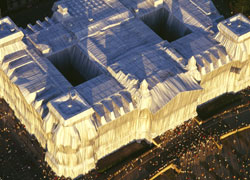February 16, 2005
In the eye of the beholder #2
What do you call 7500 gates, each sixteen feet high, ranging in width from five feet six inches to eighteen feet, erected along twenty-three miles of footpaths? Why, a work of art, of course! In fact, according to one source, this is the largest artwork since the Sphinx.
All together, these gates contain 5,290 tons of steel, 1,089,882 square feet of saffron-covered fabric, and 315,491 feet of vinyl tubes; yet they will be taken down only sixteen days after six hundred workers set them in place. Why? Ask the artists, Christo and Jeanne-Claude:
Question: The Gates, like all of your work, is temporary and public. Why do you choose to create temporary public art?
Answer: The temporary quality of the projects is an aesthetic decision. Our works are temporary in order to endow the works of art with a feeling of urgency to be seen, and the love and tenderness brought by the fact that they will not last. Those feelings are usually reserved for other temporary things such as childhood and our own life. These are valued because we know that they will not last. We want to offer this feeling of love and tenderness to our works, as an added value (dimension) and as an additional aesthetic quality.

Here are the effects that the artists wish to create:
For those who will walk through The Gates, following the walkways, and staying away from the grass, The Gates will be a golden ceiling creating warm shadows. When seen from the buildings surrounding Central Park, The Gates will seem like a golden river appearing and disappearing through the bare branches of the trees and will highlight the shape of the footpaths.Or, in the artist's words:The 16 day duration work of art, free to all, will be a long-to-be-remembered joyous experience for every New Yorker, as a democratic expression that Olmsted invoked when he conceived a central park. The luminous moving fabric will underline the organic design of the park, while the rectangular poles will be a reminder of the geometric grid pattern of the city blocks around the park. The Gates will harmonize with the beauty of Central Park. - Source.
Question: What is the best vantage point for appreciating The Gates?Before anyone questions, the project was funded by the artists themselves, not by the City of New York. By the way, you might also call them "wrappers." (I never did like rap music, either.)
Answer: There is no particular special vantage point to experience and enjoy walking under The Gates, on 23 miles of walkways. The succession of 7,500 gates moving capriciously in the wind, projecting on one another at different levels, sometimes hiding the buildings around the park, will reveal the serpentine design of the walkways....
The artists Christo and Jeanne-Claude were born in the same hour on the same day, June 13, 1935. Christo Vladimirov Javacheff was born in Gabrovo, Bulgaria, of a Bulgarian industrialist family. Jeanne-Claude Denat de Guillebon was born in Casablanca, Morocco, of a French military family. The couple first met in Paris in 1958, while Christo was working on Packages and Wrapped Objects. Source.

Well, let's add this to the list of things I'll never get to see...
Posted by: Jay at February 16, 2005 05:54 PM